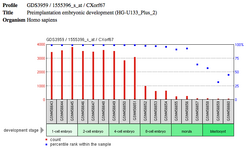Biology:CXorf67
 Generic protein structure example |
Uncharacterized protein CXorf67 is a protein that in humans is encoded by the CXorf67 gene. The Accession Number for the human gene is NM_203407.[1] Aliases include MGC47837 and LOC340602.[2] The gene is located on the positive strand of the X chromosome at Xp11.22.[2] The mRNA is 1939 base pairs long and contains 1 exon and no introns.[3]
Expression
Expression of CXorf67 in humans is generally low in all tissues. Higher RNA expression has been reported in the testis and placenta and relatively higher nuclear protein expression has been observed in the placenta, testis and ovarian follicles.[4]
Protein
The translated human CXorf67 protein is 503 amino acids in length.[3] The protein has a molecular weight of 51.9 kdal and an isoelectric point of 10.432[5]
Interactions
Protein interaction of CXorf67 with UBC (polyubiquitin-C) in humans was identified using a two-hybrid screening.[6] Currently no other protein interactions have been identified in humans.
Function
The function of CXorf67 is currently unknown, however the fusion of CXorf67 with the MBTD1 gene has been linked to low-grade endometrial stromal sarcoma in humans.[7] Sequence variants of the chromosomal region Xp11.22 are also predicted to confer susceptibility to prostate cancer in humans.[8]
References
- ↑ "CXorf67 chromosome X open reading frame 67 [ Homo sapiens (human) "]. https://www.ncbi.nlm.nih.gov/gene/340602.
- ↑ 2.0 2.1 "Chromosome X Open Reading Frame 67". https://www.genecards.org/cgi-bin/carddisp.pl?gene=CXorf67&search=55a3186b19f819043ce14e7236474a02.
- ↑ 3.0 3.1 "Homo sapiens gene CXorf67, encoding chromosome X open reading frame 67". https://www.ncbi.nlm.nih.gov/IEB/Research/Acembly/av.cgi?db=human&term=CXorf67&submit=Go.
- ↑ "CXorf67". http://www.proteinatlas.org/ENSG00000187690-CXorf67/tissue.
- ↑ "Biology Workbench". Board of Trustees of the University of Illinois. http://seqtool.sdsc.edu/CGI/BW.cgi#!.[yes|permanent dead link|dead link}}]
- ↑ "Mass spectrometric analysis of lysine ubiquitylation reveals promiscuity at site level". Molecular & Cellular Proteomics 10 (3): M110.003590. Mar 2011. doi:10.1074/mcp.M110.003590. PMID 21139048.
- ↑ "Identification of a novel, recurrent MBTD1-CXorf67 fusion in low-grade endometrial stromal sarcoma". International Journal of Cancer 134 (5): 1112–1122. Mar 2014. doi:10.1002/ijc.28440. PMID 23959973.
- ↑ "Common sequence variants on 2p15 and Xp11.22 confer susceptibility to prostate cancer". Nature Genetics 40 (3): 281–283. Mar 2008. doi:10.1038/ng.89. PMID 18264098.
External links
- Human CXorf67 genome location and CXorf67 gene details page in the UCSC Genome Browser.
 |


